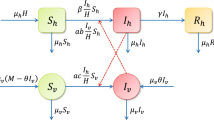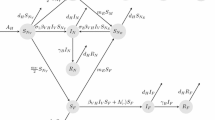Abstract
Zika is a flavivirus transmitted to humans through either the bite of infected Aedes mosquitoes or sexual intercourse with infected individuals. In this paper, we present a mathematical model based on these two modes of transmission. Using the next-generation matrix method, a threshold parameter called basic reproduction number is determined. Sensitivity analysis of the basic reproduction number in terms of parameters involved in its formulation is discussed. A dynamically consistent nonstandard finite difference scheme is designed to replicate the properties of the continuous model. Numerical simulations of the nonstandard finite difference scheme that we have constructed show the number of infected humans due to sexual intercourse with Zika virus infectious individuals. The numerical simulations also support the theoretical analysis of the model.





Similar content being viewed by others
References
Anguelov R, Lubuma JM-S (2001) Contributions to the mathematics of the nonstandard finite difference method and applications. Numer Methods Partial Differ Eq 17:518–543
Blayneh K, Cao YZ, Kwon HD (2009) Optimal control of vector-borne diseases: treatment and prevention. Discret Contin Dyn Syst Ser B 11:587–611
Bonyah E, Khan MA, Okosun KO, Islam S (2017) A theoretical model for Zika virus transmission. PLoS ONE 12(10):1–26
Brauer F, van den Driessche P, Wu J (eds) (2008) Mathematical epidemiology, mathematical biosciences, lecture notes in mathematics, vol 1947. Springer, Berlin
Brauer F, Castillo-Chavez C (2012) Mathematical models for communicable diseases, vol 84. SIAM, Philadelphia
Cao-Lormeau V et al (2014) Zika Virus, French Polynesia, South Pacific, 2013. Emerg Infect Dis 20(6):1085–1086
Davidson A, Slavinski S, Komoto K, Rakeman J, Weiss D (2016) Suspected female to male sexual transmission of Zika virus \(-\) New York City, 2016. Morb Mortal Wkly Rep 65(28):716–717
De Carvalhoa NS, De Carvalhob BF, Fugac CA, Dorisb B, Biscaia ES (2016) Zika virus infection during pregnancy and microcephaly occurrence: a review of literature and Brazilian data. Braz J Infect Dis 20(3):282–289
Dick G (1952) Zika Virus (I). Isolations and serological specificity. Trans R Soc Trop Med Hyg 46(5):509–520
Diekmann O, Heesterbeek J (2000) Mathematical epidemiology of infectious diseases. Wiley, Hoboken
Duffy M et al (2009) Zika virus outbreak on Yap Island Federated States of Micronesia. New Engl J Med 260:2536–2543
Dubrulle M, Mousson L, Moutailler S, Vazeille M, Failloux A-B (2009) Chikungunya virus and Aedes mosquitoes: saliva is infectious as soon as two days after oral infection. PLoS ONE 4(6):e5895. https://doi.org/10.1371/journal.pone.0005895
European Centre for Disease Prevention and Control (2016) Rapid risk assessment: Zika virus epidemic in the Americas: potential association with microcephaly and Guillain–Barre syndrome. Stockholm, January 21, (2016)
Foy B et al (2011) Probable non-vector-borne transmission of Zika virus, Colorado, USA. Emerg Infect Dis 17:1–7
Funk S et al (2016) Comparative analysis of dengue and Zika outbreaks reveals differences by setting and virus. PLOS Negl Trop Dis 10(12):1–16
Gao D, Lou Y, He D, Porco TC, Kuang Y, Chowell G, Ruan S (2016) Prevention and control of Zika as a mosquito-borne and sexually transmitted disease: a mathematical modelling and analysis. Sci Rep 6:1–10
Garceez P et al (2016) Zika virus impairs growth in human neurospheres and brain organoids. Science 352(6287):816–818
Hayes E (2009) Zika virus outside Africa. Emerg Infect Dis 15(9):1347–1350
Hethcote HW (1976) Qualitative analysis of communicable disease models. Math Biosci 28:335–356
Hills S et al (2016) Transmission of Zika virus through sexual contact with travelers to area of ongoing transmission—Continental United States, 2016. Morb Mortal Wkly Rep 65(8):215–216
Jamil Z, Waheed Y, Durrani TZ (2016) Zika virus, a pathway to new challenges. Asian Pac J Trop Med 9(7):626–629
Kraemer M, et al. (2015) The global distribution of the arbovirus vector Aedes aegypti and Ae. albopictus, London School of Hygiene and Tropical Medicine, and Public Health England, United Kingdom 1–18
Kucharski A (2016) Transmission dynamics of Zika virus in island populations: a modelling analysis of the 2013-14 French Polynesia outbreak. PLOS Negl Trop Dis 10(5):1–15
Ioos S et al (2014) Current Zika virus epidemiology and recent epidemics. Med et maladies infectieuses 44:302–307
Manore C et al (2014) Comparing dengue and chikungunya emergency and endemic transmission in A. aegypti and A. albopictus. J Theor Biol 356:174–191
Martcheva M (2015) An introduction to mathematical epidemiology, text in applied mathematics, vol 61. Springer, Berlin
Martines R et al (2016) Evidence of Zika virus infection in brain and placental tissue from two congenitally infected newborns and two fetal losses-Brazil, 2015. Morbid Mortal Wkly Rep 65(6):159–160
Mickens RE (1994) Nonstandard finite difference models of differential equations. World Scientific, Singapore
Musso D et al (2014) Potential for Zika virus transmission through blood transfusion demonstrated during an outbreak in French Polynesia, November 2013 to February 2014. Eurosurveillance 19(14):20761
Padmanabhan P, Seshaiyer P, Castillo-Chavez C (2017) Mathematical modelling, analysis and simulation of the spread of Zika with influence of sexual transmission and preventive measures. Lett Biomath 4(1):148–166
Ruiz-Moreno D, Vargas IS, Olson KE, Harrington LC (2012) Modelling dynamic introduction of Chikungunya virus in the United States. PLoS Negl Trop Dis 6(11):e1918. https://doi.org/10.1371/journal.pntd.0001918
Schuler-Faccini L et al (2016) Possible association between Zika virus infection and Microcephaly-Brazil, 2015. Morbid Mortal Wkly Rep 65(8):215–216
Simpson D (2016) Zika virus infection in man. Trans R Soc Trop Med Hyg 65(3):59–62
Smith H (1995) Monotone dynamical systems: an introduction to the theory of competitive and cooperative system. American Mathematical Society, Providence
Stuart AM, Humphries AR (1998) Dynamical Systems and numerical analysis. Cambridge University Press, Cambridge
van der Driessche P, Watmough J (2008) Further notes on the basic reproduction number. In: Brauer F, van der Driessche P, Wu J (eds) Mathematical epidemiology, lecture notes in mathematical biosciences subseries, vol 1945. Springer, Berlin, pp 159–178
Wong P-SJ, Li MI, Chong C-S, Ng L-C, Tan C-H (2013) Aedes (Stegomyia) albopictus (Skuse): a potential vector of Zika virus in Singapore. PLoS Negl Trop Dis 7(8):e2348. https://doi.org/10.1371/journal.pntd.0002348
Wonham MJ et al (2006) Transmission assumptions generate conflicting predictions in host-vector disease models: a case study in West Nile virus. Ecol Lett 9:706–725
Yakob L, Clements ACA (2013) A mathematical model of Chikungunya dynamics and control: the major epidemic on Réunion Island. PLoS ONE 8(3):e57448. https://doi.org/10.1371/journal.pone.0057448
Zanluca C et al (2015) First report of autochthonous transmission of Zika virus in Brazil. Mem Inst Oswaldo Cruz, Rio de Janeiro 110(4):569–572
Zhang Q et al (2017) Spread of Zika virus in the Americas. PNAS 2017: E4334–E4343
World Health Organization (2016a) WHO disease outbreak news, March, 10 (2016)
World Health Organization (2016b) WHO statement on the first meeting of the International Health Regulations 2005. Emergency committee on Zika virus and observed increase in neurological disorders and neonatal malformations, February, 1, 2016
Acknowledgements
The authors acknowledge the financial support of the DST/NRF SARChI Chair in Mathematical Models and Methods in Bioengineering and Biosciences from the University of Pretoria and University of South Africa. The authors are grateful to the anonymous reviewers, and the Handling Editor, for their suggestions that have greatly improved the paper.
Author information
Authors and Affiliations
Corresponding author
Rights and permissions
About this article
Cite this article
Terefe, Y.A., Gaff, H., Kamga, M. et al. Mathematics of a model for Zika transmission dynamics. Theory Biosci. 137, 209–218 (2018). https://doi.org/10.1007/s12064-018-0272-7
Received:
Accepted:
Published:
Issue Date:
DOI: https://doi.org/10.1007/s12064-018-0272-7




